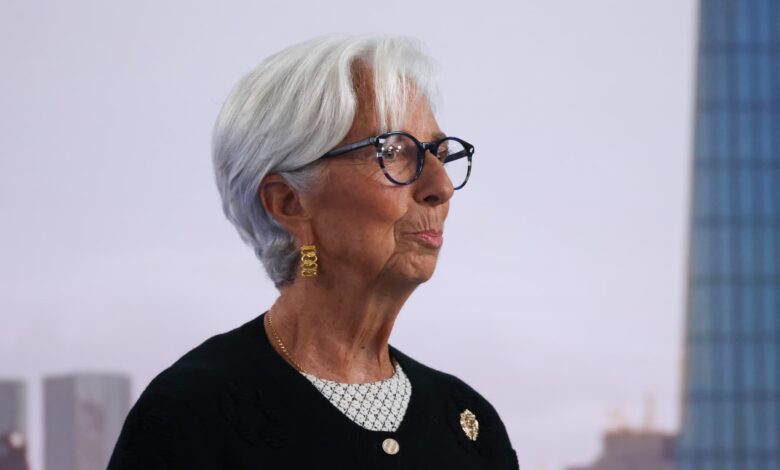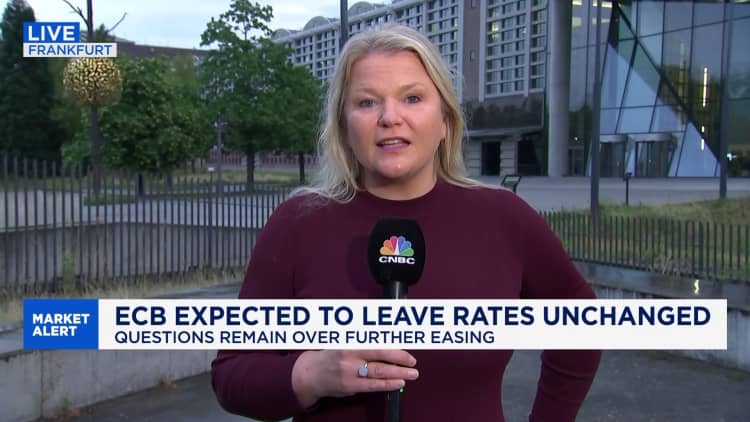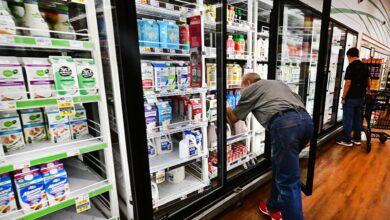European Central Bank leaves rates unchanged as tariff fallout lingers

The European Central Bank held interest rates steady on Thursday as economic uncertainty persists in the wake of U.S. Donald Trump’s aggressive tariff agenda.
Ahead of the decision, markets had been pricing in an around 99% chance of the ECB’s key deposit facility rate being left at 2% for the second consecutive time. The central bank last cut rates in June, bringing rates further down from last year’s record high of 4%.
“Inflation is currently at around the 2% medium-term target and the Governing Council’s assessment of the inflation outlook is broadly unchanged,” the ECB said in a statement.
The central bank added that it would follow a meeting-by-meeting, data-dependent approach and was not pre-committing to a specific path for interest rates. The ECB offered little indication on the future direction for rates.
Lingering economic uncertainty
The ECB is grappling with global economic uncertainty, despite inflation in the euro zone hovering around the central bank’s 2% target in recent months, and the EU striking a trade agreement with the U.S.
The transatlantic partners agreed to 15% blanket tariffs on EU exports to the U.S. in July, with further details about the framework emerging last month. It addressed some questions for key European sectors like pharmaceuticals.

However, questions remain as some issues — such as provisions for the wine and spirits sector — were left open. Concerns over further tariffs have also grown following Trump’s threat of retaliations against the EU after it hit Alphabet‘s Google with a $3.45 billion antitrust fine.
Fears about the impact tariffs could have on economic growth remain. Growth in the euro zone has remained sluggish even as rates have come down, with the latest figures showing just 0.1% growth in the second quarter after a 0.6% expansion in the previous period.
Lagarde on Thursday noted that “risks to economic growth have become more balanced.”
“While recent trade agreements have reduced uncertainty, a renewed worsening of trade relations could further dampen exports and drag down investment and consumption,” she said. Lagarde also noted that “the outlook for inflation remains more uncertain than usual as a result of the still volatile trade policy environment.”
In response to a question from CNBC’s Annette Weisbach, Lagarde added that trade uncertainty had “clearly diminished” as risks like European retaliation against U.S. policy have diminished. But, Lagarde said, uncertainty has not returned to “normal”, pre-Covid levels, adding that “maybe there will not be a normal level.”
Further cuts ahead?
Economists and analysts appeared divided on whether to expect more rate cuts looking ahead.
Based on economic expectations, the central bank “is in no hurry to reduce rates further,” said Thomas Pugh, chief economist at consulting firm RSM.
But, he noted, “the 15% tariff on EU exports to the U.S. along with heightened uncertainty will weigh on demand, potentially leaving the door open to a further rate cut at the end of the year.”
“A combination of a hit to investment and exports, a stronger euro along with cheaper imports from China could dampen growth and inflation by enough to warrant another rate cut later this year,” Pugh explained in a note.
Elsewhere, Irene Lauro, euro zone economist at Schroders, said that Thursday’s announcements “confirm our view that the easing cycle has ended.”
Lauro sees trade uncertainty fading and the euro zone’s economic recovery accelerating as companies become less cautious and labor markets continue to be tight.
“Risks have shifted for the eurozone from trade uncertainty to political instability, with France now in the fiscal spotlight. But the resilience of the economy and strengthening domestic demand means the ECB can afford to keep monetary policy unchanged,” she said.
Updated expectations
With the interest rate decision itself being widely anticipated, attention on Thursday focused on Lagarde’s press conference and the latest projections for inflation and economic growth. The central bank last updated its economic forecasts in June.
“The new ECB staff projections present a picture of inflation similar to that projected in June. They see headline inflation averaging 2.1% in 2025, 1.7% in 2026 and 1.9% in 2027,” the central bank said.
In June, headline inflation was forecast to average 2% this year, 1.6% next year and 2% in 2027.
So-called core inflation, which strips out food and energy costs, is expected to average 2.4% this year, unchanged from the previous estimate.
Looking at economic growth, the ECB said that “the economy is projected to grow by 1.2% in 2025, revised up from the 0.9% expected in June.”
The forecast for 2026 was trimmed slightly to 1% growth.




